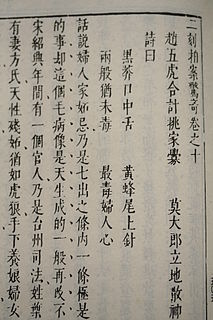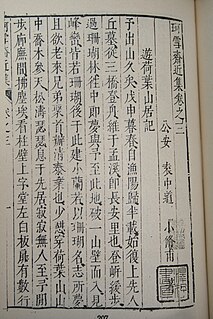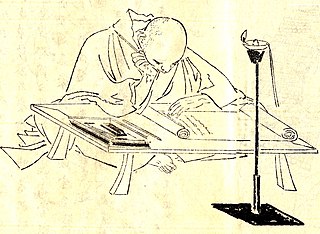Tu Long, was a playwright and essayist who lived during the Ming Dynasty. He was born in Yin county.
In sinology, the Classic Chinese Novels are two sets of the four or six best-known traditional Chinese novels. The Four Classic Novels include Romance of the Three Kingdoms, Journey to the West, Water Margin and Dream of the Red Chamber, and the Six Classic Novels add Rulin waishi and Jin Ping Mei to this list. These are among the world's longest and oldest novels, and they are the most read, studied and adapted works of pre-modern Chinese fiction.

Li He was a Chinese poet of the mid-Tang dynasty. His courtesy name was Changji, and he is also known as Guicai and Shigui.

Yuan Hongdao was a Chinese poet of the Ming Dynasty, and one of the Three Yuan Brothers, along with his brothers Yuan Zongdao and Yuan Zhongdao. His life spanned nearly the whole of the Wanli period (1573-1620) in Chinese history. Yuan was from Gong'an in Hukuang. His family had been military officials for generations. Yuan showed an interest in literature from youth and formed his own literary club at age fifteen. At the age of twenty-four in 1592 he took the chin-shih examination and subsequently received an official position in 1595. However he quit out of boredom after a year. Yuan traveled and consulted with the radical philosopher Li Zhi. On another trip his brothers joined him. Hu's elder brother was a Buddhist-Confucianist synchronist. His travels resulted in his publishing a poetry compilation Jietuo ji [Collection of One Released]. His and his two brothers' poetry, which focused on clarity and sincerity, produced a following eventually known as the Gong'an school, the central belief of which was that good writing was a result of genuine emotions and personal experience. When one of his brothers died in 1600, Yuan retired to a small island in a lake to meditate and write poetry. The resulting work is Xiaobi tangji [Jade-Green Bamboo Hall Collection].

Ling Mengchu was a Chinese writer of the Ming Dynasty. He is best known for his vernacular short fiction collections Slapping the Table in Amazement (拍案驚奇), I and II.

Yuan Zhongdao was a Chinese poet, essayist, travel diarist and official was born in Kung-an in Hukuang. He shares his fame with two other brothers, Yuan Zongdao (1560–1600) and Yuan Hongdao (1568–1610); they are collectively known as the Three Yuan Brothers. The three brothers dominated the literature of the period. From a family of financial means, they printed and distributed their own works. The youngest of the brothers, Yuan Zhongdao, took years in his pursuit of a civil-service examination degree. The brothers were all openly ambivalent about social position. Yuan Zhongdao spent quantities of money on boats for his extended excursions. His brothers and their families were haunted by disease. Yuan Zhongdao's own life was a story of breakdown at the cumulative stress of family deaths and repeated failure at the civil service examination. Yuan Zhongdao's principal health problem was perhaps tuberculosis. Yuan Zhongdao would record extremes of mood within even a daily period suggesting perhaps bipolar disorder. Yuan Zhongdao was denied the complete rest he needed for such a condition due to pressing family needs. Yuan's diary, Yu chü-fei lu is his literary monument. Yuan's precarious physical and psychological condition provided the background for his preoccupation with longevity and stress avoidance. He avoided a Buddhistic vegetarian diet, perceiving a need for protein in his diet. Excessive drinking and too many wives were other perceived impediments. His travel diary is full of such detail. Yuan records an early reading of the celebrated novel Jin Ping Mei. He was likewise associated with the radical philosopher Li Zhi 李贄 (1527–1602) and his espousals of popular literature. Likewise Yuan Zhongdao had the acquaintance of the Jesuit missionary Matteo Ricci (1552–1610). In 1616 he passed the Imperial examination and obtained a succession of official posts.

Chen Jiru was a Chinese landscape painter, calligrapher and essayist during the Ming Dynasty (1368–1644).

The Zhuangzi is an ancient Chinese text from the late Warring States period (476–221 BC) which contains stories and anecdotes that exemplify the carefree nature of the ideal Daoist sage. Named for its traditional author, "Master Zhuang" (Zhuangzi), the Zhuangzi is—along with the Tao Te Ching—one of the two foundational texts of Daoism, and is generally considered the most important of all Daoist writings.
A huaben is a Chinese short- or medium-length story or novella Setsuwa(Chinese: 說話; pinyin: shuō huà, Japanese: 説話, translit. setsuwa) written mostly in vernacular language, sometimes including simple classical language. In contrast to the full-length Chinese novel, it is generally not divided into chapters and recounts a limited number of characters or events. The earliest huaben are reported in the 12th century during the Song dynasty, but the genre did not flourish until the late Ming dynasty, and after the mid-17th century did not produce works of originality. In the development of Chinese fiction, the huaben are heirs of the bianwen and chuanqi of the Tang dynasty, and are the predecessors of the stories and full-length novels of the Ming.

Bianwen is a technical term referring to a literary form that is believed to be some of the earliest examples of vernacular and prosimetric narratives in Chinese literature. These texts date back to the Tang Dynasty (618–907) and Five Dynasties (907–960) periods, and were first discovered among a cache of manuscripts at Dunhuang, Gansu Province, China in the early twentieth century.
Li Baojia, courtesy name (zi) Li Boyuan, art name nickname (hao) Nanting tingzhang was a Qing Dynasty-era Chinese author. He was a writer, essayist, ballad author, poet, calligrapher, and seal carver. He edited a fiction periodical and several tabloids.
Wenming Xiaoshi is a novel by Li Baojia. The novel is a satire of pseudo-reformers in the Qing Dynasty period who found difficulty adjusting to modernization, including its complexities and problems. The work has 60 chapters but it is a shorter work than Officialdom Unmasked.
Wen fu, translated as "Essay on Literature", "The Poetic Exposition on Literature" or "Rhymeprose on Literature", is an important work in the history of fu poetry itself written in the Fu poetic form by the poet, general, and statesman Lu Ji (261–303), which expounds the philosophical basis of poetry and its rhetorical forms. Achilles Fang wrote that it is considered "one of the most articulate treatises on Chinese poetics. The extent of its influence in Chinese literary history is equaled only by that of the sixth-century The Literary Mind and the Carving of Dragons of Liu Xie. It is called a "hymn of praise for the craft and art of writing and a specific, prescriptive handbook for the writer."
Chinese culture has had a tremendous impact in many areas of Korean culture, including arts, written language, religion and government administration, with Koreans molding these Chinese models into distinctly Korean forms.
Zong-qi Cai (蔡宗齊) is a bicultural U.S./China academic based at the University of Illinois at Urbana-Champaign, where he teaches Chinese literature and Classical Chinese poetry and leads the Forum on Chinese Poetic Culture. Cai also teaches as the Lee Wing Tat Chair Professor of Chinese Literature at Lingnan University. Widely published in both English and Chinese, Prof. Cai puts equal emphasis on individual research, collective contributions and the development of a mutually beneficial East-West literary academic culture.
Yuan Jie (719/723–772) was a Chinese poet and man of letters of the mid-Tang period. His courtesy name was Cishan, and he had several art names.











